Table Of Contents
- Why Osaka's Famous Spots Hit Different
- The Heart of It All: Osaka Castle
- Universal Studios Japan: More Than Just Theme Park Thrills
- The Transportation Hub Reality: Osaka Station and Beyond
- Namba: The Soul of Osaka Street Life
- The Umeda Sky Building: Modern Osaka Reaching for the Sky
- Osaka Aquarium: Where the City Meets the Sea
- Museum Culture: Where Osaka's Past Meets Present
- The Trendy Side: Orange Street and Modern Osaka
- Food Culture Beyond the Tourist Spots
- Day Trip Possibilities from Osaka
- When Osaka Shows Its Best Side
- The Reality Check: What to Expect
- Beyond the Headlines: Why These Places Matter
- Making the Most of Your Visit
- The Local Perspective on Tourism
- Final Thoughts: What Osaka's Places Really Offer
Listen, I've lived in this city my whole life and still get excited walking through specific neighborhoods. But here's the thing about famous places in Osaka: they're not just photo ops. Each one tells you something different about who we are as Osakans. Some will make you laugh until your sides hurt, others will have you questioning everything you thought you knew about Japanese history, and a few might just change how you see an entire city.
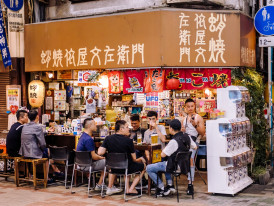
Busy Osaka street with locals chatting and laughing over food
Why Osaka's Famous Spots Hit Different
Before we dive into the specifics, let me tell you why these places matter. Osaka isn't like other major cities in Japan, where everything feels polished and predictable. We're loud, we're proud of our delicious food, and we don't take ourselves too seriously. That energy shows up everywhere, from our ancient castles to our modern stations.
These attractions aren't just tourist traps (though some definitely feel that way during peak season). They're where our daily life intersects with centuries of history, where modern Japan meets traditional culture, and where you can really understand why we Osakans are so obsessed with good food and bad jokes.
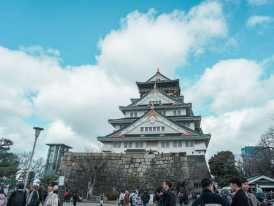
Early morning view of Osaka Castle with soft golden light and few visitors
The Heart of It All: Osaka Castle
Osaka Castle dominates our skyline for good reason. Every visitor expects the classic Japanese castle experience, and they get it, sort of. The structure itself is magnificent, especially during cherry blossom season. But here's what guidebooks won't tell you: the current building is a 1931 reconstruction, then rebuilt again after World War II.
I remember bringing my friend from Tokyo here for the first time. He kept going on about how "authentic" everything felt until I mentioned the elevator inside. His face was priceless. The thing is, that doesn't make the castle any less impressive. The grounds are stunning, the views from the top floor are unbeatable, and the museum inside actually does a decent job of explaining our city's role in Japanese history.
The best time to visit isn't during peak tourist hours. Come early morning when the light hits the white walls just right, or late afternoon when the crowds thin out. The park surrounding the castle is where locals hang out, families have picnics, old men play chess, and kids run around like maniacs.
From the castle grounds, you can see how central Osaka spreads out in all directions. It's one of those moments where you realize how this entire city grew up around this single point of power and history.
Pro tip from a local: Skip the overpriced food inside the castle grounds. Walk five minutes to nearby streets, and you'll find family-run restaurants that have been feeding castle workers for generations.
Looking for a private city experience in Osaka?
Explore the city with a local who plans a private day just for you; no groups, no scripts.

Universal Studios Japan decorated for Halloween with elaborate decorations and costumed visitors Photo by Huu Huynh by pexels
Universal Studios Japan: More Than Just Theme Park Thrills
Universal Studios Japan wasn't even on my radar when it first opened in 2001. Theme parks felt like something for tourists and families with kids. But over two decades, USJ has become genuinely part of Osaka city culture.
The experience here hits different than in Hollywood or Orlando. Japanese attention to detail means every attraction feels polished to perfection. The staff enthusiasm isn't fake; it's that genuine Japanese omotenashi hospitality mixed with Osaka's natural friendliness.
The seasonal events are where USJ really shines. Halloween here isn't just costumes and candy; it's a city-wide celebration that spills out into the streets. The Christmas illuminations are so elaborate that they put most major cities to shame.
But honestly, the best part is watching how differently people behave here compared to elsewhere in Japan. Everyone's louder, more expressive, and more willing to act silly. It's like the park gives everyone permission to be more Osakan.
Reality check: Yes, it's expensive. Yes, it gets insanely crowded. But if you're doing a day trip, spring for the Express Pass. Trust me on this one.

Aerial view of Kansai International Airport on its artificial island photo by NASA Earth Observatory on Wikicommons
The Transportation Hub Reality: Osaka Station and Beyond
Osaka Station: Beautiful Chaos
Osaka Station is where first-time visitors either fall in love with our city or decide they never want to come back. It's massive, confusing, and constantly buzzing with activity. But once you figure out the flow, it becomes this incredible window into daily Osaka life.
The station itself is architecturally stunning, all glass and steel and soaring ceilings. But what I love most about Osaka Station is how it connects to everything. Underground shopping, department stores, restaurants, and direct access to most places you'd want to visit in central Osaka.
The Shin Osaka Station Experience
Shin Osaka Station is different entirely. It's where the bullet train connects our city to the rest of Japan. Less atmospheric than the main station, but incredibly efficient. The one hour train ride to Kyoto starts here, as does the journey to Tokyo.
I've probably passed through Shin Osaka Station hundreds of times, but I still get a little thrill seeing those sleek trains lined up. It represents how connected we are to other major cities while maintaining our distinct Osaka identity.
Local insight: The best food at Shin Osaka Station isn't on the fancy restaurant floors; it's the bento boxes from the convenience stores on the lower level. Cheaper, fresher, and exactly what locals grab for bullet train journeys.
Airport Connections and Train Stations
Most international visitors get their first taste of Osaka through Kansai International Airport. Built on an artificial island, it's an engineering marvel that feels very different from Narita Airport near Tokyo. Unlike Narita Airport, which serves the greater Tokyo area, KIX feels more integrated into the regional transport network. The train ride from Kansai International Airport into central Osaka gives you this great preview of how our city transitions from modern industrial areas to dense urban neighborhoods.
The connections from Kansai International Airport to the city center are clean, efficient, and staffed with people who actually seem happy to help tourists figure out their routes. The train stations connecting the airport feel welcoming rather than intimidating, which sets a good tone for your visit.
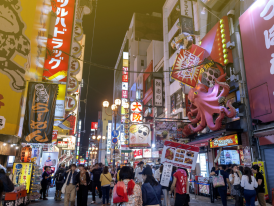
Interior of a traditional covered shopping arcade near Namba with small shops and local customers
Namba: The Soul of Osaka Street Life
Why Namba Station Matters
Namba Station isn't just a transit hub; it's the beating heart of Osaka's street culture. The energy here is different from anywhere else in Japan. Brighter, louder, and more in-your-face. This is where you'll understand why people call us the "Kitchen of Japan."
The area around Namba Station is where Japanese cuisine meets street performance, where traditional shopping arcade culture thrives alongside modern entertainment. It's organized chaos at its finest.
Dotonbori: Tourist Central with Real Character
Everyone ends up in Dotonbori eventually. It's touristy but also genuinely representative of Osaka's personality. The giant mechanical crab, the Glico runner sign, the canal lined with restaurants, it's over-the-top in the best possible way.
Delicious food is everywhere in this area, but so are tourist traps. The trick is looking for places where locals are eating alongside visitors. If you see a line of salarymen waiting patiently next to confused tourists, you've found somewhere worth trying.
The Shopping Arcade Experience
The shopping arcade culture around Namba Station is something you won't find in other major cities. These covered walkways have been commercial centers for centuries, and they still feel alive in ways that modern malls don't.
Each shopping arcade has its own personality. Some specialize in traditional crafts, others in modern fashion. The best ones mix everything together. You'll find a shop selling traditional tea ceremony equipment next to one selling the latest smartphone accessories.
What if your day in Osaka was planned by someone who knows it — and you?
City Unscripted matches you with a local host who creates a private experience based on your interests, not a set route.
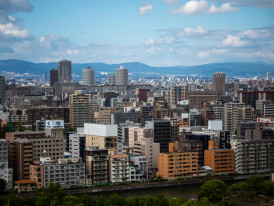
Panoramic view of Osaka city from the Umeda Sky Building observation deck Photo by Samuel Seelig on pexels
The Umeda Sky Building: Modern Osaka Reaching for the Sky
The Umeda Sky Building represents modern Osaka's ambition perfectly. Two towers connected by a "floating" observatory, it looks like something from a science fiction movie. When it was completed in 1993, people thought it was completely over-the-top. Now it's become one of our most recognizable landmarks.
The views from the observation deck show you how central Osaka connects to suburban areas, how our rivers wind through the urban landscape, and how close we actually are to other cities in the Kansai region.
From up there, you can see almost everything that makes Osaka special. The castle to the south, the port areas where international trade has shaped our city for centuries, and the residential neighborhoods where millions of people live their daily lives.
The building is especially beautiful at sunset. The whole city lights up gradually, and you can watch how different neighborhoods have their own rhythms of activity.
Practical tip: The basement has an entire restaurant floor designed to look like early 20th-century Osaka streets. It's touristy but fun, and the food is actually quite good.
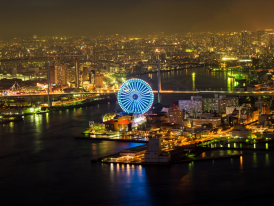
Tempozan Harbor Village with ferris wheel and harbor views near Osaka Aquarium
Osaka Aquarium: Where the City Meets the Sea
Kaiyukan's Massive Scale
The Osaka Aquarium (officially called Kaiyukan) is one of those attractions that sounds like it might be boring but ends up being genuinely amazing. The scale is enormous; you're basically walking through a representation of the Pacific Ocean ecosystem.
What makes the Osaka Aquarium special isn't just the size of the tanks or the variety of sea life. It's how the experience is designed. You start at the top and spiral down through different ocean environments, like you're actually descending into the deep sea.
The Whale Shark Experience
The main tank at the Osaka Aquarium contains whale sharks, and seeing them up close is genuinely moving. These massive, gentle creatures swimming in what feels like an ocean-sized tank put everything into perspective.
My nephew was terrified of the ocean until we brought him to the Osaka Aquarium. Watching him go from scared to fascinated to completely obsessed over the course of a few hours, that's the kind of experience that makes these attractions worth visiting.
Beyond the Main Exhibits
The Osaka Aquarium also connects to Tempozan Harbor Village, which gives you great views of Osaka Bay and the port areas crucial to our city's development. You can see how Osaka has always been connected to the inland sea and international trade.
Insider knowledge: The Osaka Aquarium is much less crowded on weekday mornings. If you're planning a day trip with multiple attractions, start here early.
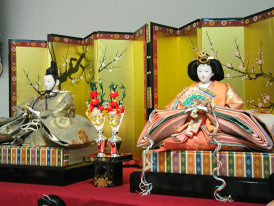
Traditional Japanese artifacts and cultural displays at the Osaka Museum Photo by keiko Tokuriki on Unsplash
Museum Culture: Where Osaka's Past Meets Present
The Osaka Museum of History
The Osaka Museum of History is clever. Instead of just displaying artifacts, it shows how layers of history built up over time in the same location. Through glass floors, you can see archaeological remains, reconstructed historical scenes, and modern exhibits, all in the same building.
What I appreciate about the Osaka Museum is how it doesn't romanticize the past. It shows you how ordinary people lived, worked, and struggled throughout different periods of Japanese history. The reconstructed Edo-period market scenes feel surprisingly similar to modern Osaka markets.
Traditional Arts and Modern Expression
The Osaka Museum also covers how Japanese culture evolved differently here compared to Japan's capital city. We were always more merchant-focused, more practical, and more willing to adapt foreign influences to suit local needs.
The tea ceremony exhibits show how even formal traditions were adapted to Osaka's more relaxed style. Everything feels a bit more approachable and less intimidating than similar exhibits in other cities.
Tip
We match you with the right host, not just any guide.Want to experience the real Osaka with someone who lives there?
A fully private experience, planned and led by a local host who tailors the day to you

Contrast between modern Orange Street shops and traditional storefronts nearby Photo by Darina on Unsplash
The Trendy Side: Orange Street and Modern Osaka
This area around America-mura (American Village) represents modern Osaka youth culture, fashion-forward, slightly rebellious, and completely unpretentious. Young Osakans have been coming here to express themselves for decades.
The shops mix vintage American clothing with Japanese street fashion, independent music stores with trendy cafes. It's not polished like shopping districts in other major cities, it's more organic, more experimental.
What's interesting is how this area exists alongside traditional shopping districts. In just a few minutes, you can walk from cutting-edge fashion boutiques to century-old shopping arcade vendors.
This mixing of old and new is classic Osaka. We don't throw away the past to make room for the future; we just squeeze everything together and make it work.

Small family restaurant in a residential area with locals enjoying a meal.
Food Culture Beyond the Tourist Spots
Kuromon Ichiba Market gets mentioned in every Osaka food guide, and yes, it's worth visiting. But understand what you're getting into. Parts of it have become quite touristy, with vendors calling out in multiple languages and prices adjusted for international visitors.
The real treasures are the stalls that still primarily serve locals. Look for places where the signage is only in Japanese, where older Osakans are doing their daily shopping, and where the focus is on quality rather than presentation.
The best delicious food in Osaka isn't always in restaurants. Some of my favorite meals happen at tiny street stalls, in small shops that have been family-run for generations, or in places that don't even have names, just "the takoyaki place by the train bridge."
Green onions show up in almost everything we eat here, along with that distinctive Osaka-style sauce that's slightly sweeter than what you'll find in other regions. These flavor preferences developed over centuries of merchant culture and international trade influences.
Every neighborhood has its own cluster of small restaurants, usually near the local station. These neighborhood spots serve Japanese cuisine that's comfortable rather than fancy, the kind of food that makes you understand why we're so proud of our eating culture.
The great restaurants aren't always the ones with Michelin stars or English menus. Sometimes they're the places where the mama-san remembers how you like your ramen after visiting twice.
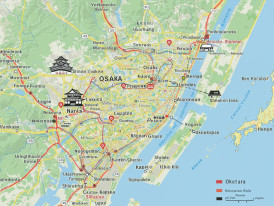
Map showing Osaka's central location and easy connections to surrounding cities and attractions
Day Trip Possibilities from Osaka
Easy Escapes Within Reach
One advantage of Osaka's central location is how easy it is to take a day trip to completely different environments. A short walk to any major train station connects you to mountain temples, coastal towns, traditional craft villages, and other major urban centers.
The one hour train ride to places like Nara, Kyoto, or Kobe gives you perspective on how different each city in the Kansai region feels despite their proximity. Each has developed its own personality over centuries.
Understanding Regional Connections
These day trip options help you understand why Osaka developed as a commercial center. We're positioned perfectly to connect mountain resources, coastal trade, and agricultural areas. That geographic advantage shaped our culture of practical innovation and openness to outside influences.
Even a day trip to nearby areas helps explain why Osaka feels different from Japan's capital city or other major urban centers. We developed as a hub rather than a destination, which made us more adaptable and less formal.
Ready to plan your perfect day in Osaka?
Start your experience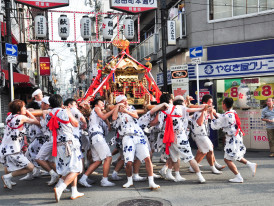
Energetic festival celebration in Osaka with traditional portable shrines and enthusiastic participants
When Osaka Shows Its Best Side
Each season brings out different aspects of Osaka's personality. Spring cherry blossoms transform parks and riversides into celebration spaces. Summer festivals fill the streets with energy. Autumn colors make even industrial areas beautiful. Winter illuminations turn shopping districts into wonderlands.
But honestly, the best time to experience Osaka is whenever you can stay long enough to get past the surface attractions. The city gradually reveals itself: first, the obvious tourist spots, then the neighborhood culture, and finally, the daily rhythms that make locals love living here.
Osaka festivals aren't polite, quiet affairs. We celebrate loudly, enthusiastically, and with complete commitment to having a good time. The Tenjin Matsuri in summer, various neighborhood festivals throughout the year, and spontaneous celebrations when our baseball team wins. This is when you see the real Osaka spirit.
These moments happen in the same spaces as daily life, the streets around major stations, the areas near shopping arcade entrances, the parks that surround historical sites.
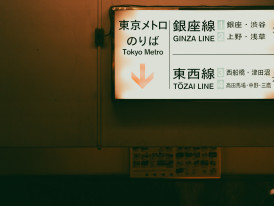
Multilingual signage at a major Osaka train station with tourists consulting maps Photo by ayumi kubo on Unsplash
The Reality Check: What to Expect
Crowded but Friendly
Let's be honest about what visiting famous Osaka attractions actually involves. Crowds, especially during peak tourist seasons and weekends. Lines for popular restaurants. Difficulty getting good photos without other people in them. Higher prices in tourist-heavy areas.
But here's the thing about Osaka crowds: they're generally good-natured. People help each other navigate confusing train stations, share recommendations for delicious food, and make room for everyone to enjoy the famous sights. The energy is inclusive rather than competitive.
Language and Navigation
Most major attractions have English signage and staff who can communicate in English. Train stations are well-marked with multiple languages. Tourist information is widely available. But learning a few basic Japanese phrases makes everything smoother and shows respect for local culture.
Navigation apps work well in Osaka, but don't rely entirely on technology. Sometimes the best discoveries come from getting slightly lost and stumbling onto neighborhood gems that don't appear in guidebooks.
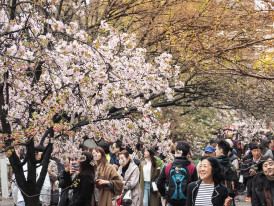
Tourists and local families sharing space and conversation in Osaka Castle park.
Beyond the Headlines: Why These Places Matter
Cultural Significance
The famous attractions in Osaka aren't just tourist destinations; they're places where Japanese culture continues to evolve and adapt. Osaka Castle represents historical continuity. Universal Studios Japan shows how global entertainment gets filtered through local sensibilities. The various train stations demonstrate Japanese efficiency and design excellence.
Each major attraction connects to broader themes about how modern Japan balances tradition with innovation, how local identity persists despite globalization, and how public spaces can serve multiple communities simultaneously.
Personal Connections
What makes these places special isn't their individual features but how they connect to each other and to daily Osaka life. You might visit Osaka Castle as a tourist, but you'll remember the conversation you had with a local family having a picnic in the park. The Osaka Aquarium is impressive, but it's the kids' excited reaction to seeing whale sharks that stays with you.
These moments of connection happen because Osaka's famous places aren't separate from regular city life; they're embedded in neighborhoods where people live, work, and raise families.

Map showing walking routes connecting major Osaka attractions with neighborhood discoveries along the way
Making the Most of Your Visit
If you're coming to Osaka for the first time, you won't see everything in one trip. That's fine. Choose a few attractions that genuinely interest you rather than trying to check every spot off a list. Quality over quantity leads to better memories and less exhaustion.
The best Osaka experiences often happen between the major attractions, walking through neighborhoods, eating at random restaurants, and chatting with locals curious about your visit. Leave time for spontaneous discoveries.
Try to understand how different attractions relate to each other geographically and culturally. The castle and the surrounding business district. Namba Station and the traditional shopping arcade culture. Modern commercial development and historical areas.
These connections help you see Osaka as a living city rather than separate tourist sites.
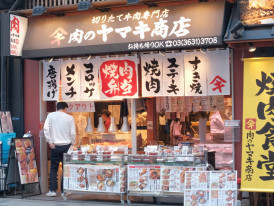
Tourists supporting a small local business near a famous Osaka attraction Photo by Mak on Unsplash
The Local Perspective on Tourism
How Osakans Feel About Visitors
Most locals appreciate visitors who show genuine interest in our city and culture. We're proud of Osaka and happy to share what makes it special. But we also appreciate when tourists understand that these are real places where real people go about their daily lives.
The best interactions happen when visitors approach famous attractions with curiosity rather than just photo opportunities. Ask questions, try local food recommendations, be patient with language barriers, and remember you're a guest in someone else's home city.
Sustainable Tourism Approach
Consider how your visit impacts local communities. Support small businesses alongside major attractions. Respect photography rules and personal space. Follow local customs around eating, walking, and public behavior. Choose Osaka experiences that benefit local communities rather than just international tourism companies.
When you're visiting a place for the first time in Osaka, remember that what seems exotic or unusual to you is someone else's typical daily environment. That perspective makes for more respectful and ultimately more rewarding travel experiences.

Sunset view over Osaka with multiple famous landmarks visible, showing the city as an integrated whole
Final Thoughts: What Osaka's Places Really Offer
The major attractions in Osaka work best when you understand them as entry points into more profound cultural experiences rather than destinations in themselves. The castle introduces you to Japanese history, but the real learning happens when you explore how that history shaped modern neighborhoods. The theme parks provide entertainment, but the lasting value comes from observing how Japanese creativity adapts global concepts.
Each attraction connects to networks of smaller experiences, family restaurants, neighborhood festivals, local shopping areas, and residential communities. They're most valuable as starting points for understanding what makes Osaka unique among major cities in Japan and around the world.
Whether you're planning your first visit or returning to explore more deeply, remember that the city's attractions are living parts of a larger cultural ecosystem. They're worth visiting not just for their individual features, but for how they help you understand the broader patterns of Osaka life, culture, and community.
That's what visiting these places in Osaka is really like, not just seeing attractions but discovering a city that's proud, practical, and endlessly welcoming to anyone who approaches it with genuine curiosity and respect.
What if your day in Osaka was planned by someone who knows it — and you?
City Unscripted matches you with a local host who creates a private experience based on your interests, not a set route.
Want to experience the real Osaka with someone who lives there?
A fully private experience, planned and led by a local host who tailors the day to you










